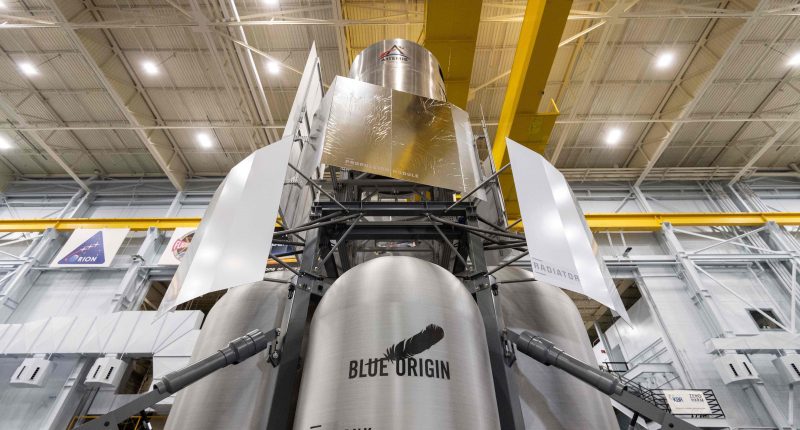Blue origin’s ‘national team’ (which consists of Lockheed Martin, Northrop Grumman and Draper) has delivered a full-sized mockup of their Human Lunar Lander to NASA for testing by engineers and astronauts. This model of the lander is currently placed in the Space Vehicle Mockup Facility at the Johnson Space Center.
The nearly 40-feet high mockup is a full-size version of the lander which includes the Decent Elements (DE) designed by Blue Origin and the Ascent Element (AE) from Lockheed Martin. However, this mockup is not fully functional. It is merely a prototype, that will enable NASA astronauts and engineers to study the model and suggest improvements. This version of the lander has been developed to allow modular solutions that enable “independent development and testing of each element’ and ” permits ongoing improvements and evolution without impacting the full system.”
The prototype will allow astronauts to simulate crew interactions to check if the ‘design’ of the spacecraft suits the needs of the mission. Thus, the testing will not include the functioning of the spacecraft but rather more superficial details like instrument and component layout, visibility through windows from the cabin, ergonomics of seating and entry and exit points etc. which can carry way more importance than space novices like us give them credit for. Moreover, this will allow Blue Origin to take input from actual astronauts, as it had been relying on help from elements of spacecraft design, as can leveraging previous designs.
“Testing this engineering mockup for crew interaction is a step toward making this historic mission real. The learning we get from full-scale mockups can’t be done any other way. Benefitting from NASA’s expertise and feedback at this early stage allows us to develop a safe commercial system that meets the agency’s needs.” said Brent Sherwood, vice president of Advanced Development Programs, Blue Origin in the official blog post.
For those unaware, the vehicle will be used to bring astronauts down to the surface of the moon and then return them to lunar orbit. It will help achieve NASA’s dream of landing the first American woman on the surface of the Moon by 2024.
Apart from Blue Origin, The National Team consists of three other companies – Lockheed Martin, Northrop Grumman, and Draper. The team was given the contract just three months ago, and it has already developed the first mockup.
“Each partner brings its own outstanding legacy to the National Team. These include developing, integrating, and operating human-rated spacecraft, launch systems, and planetary landers. Together we form an excellent team to send our next astronauts to the Moon in 2024,” said Kirk Shireman, vice president of Lunar Campaigns at Lockheed Martin Space. “Augmenting state of the art tools with physically being able to see, interact, and evaluate a full-up lander in person is critical. It will inform our design and requirements earlier in the program allowing us to accelerate our development and meet the 2024 lunar landing goal.”
Apart from The National Team, Dynetics and SpaceX were also given contacts to develop a Human Landing System (HLS) from NASA.
